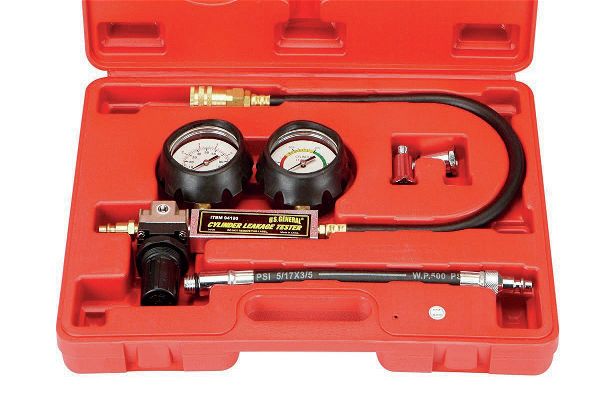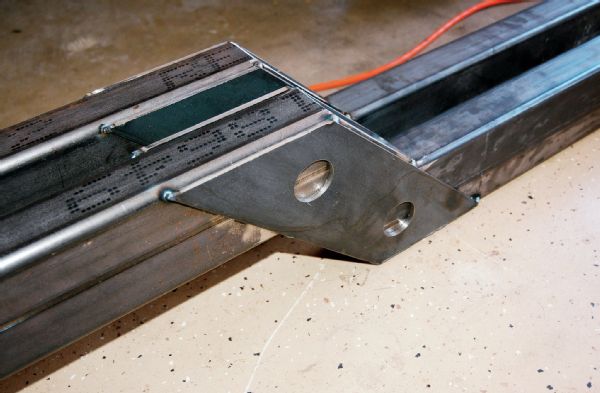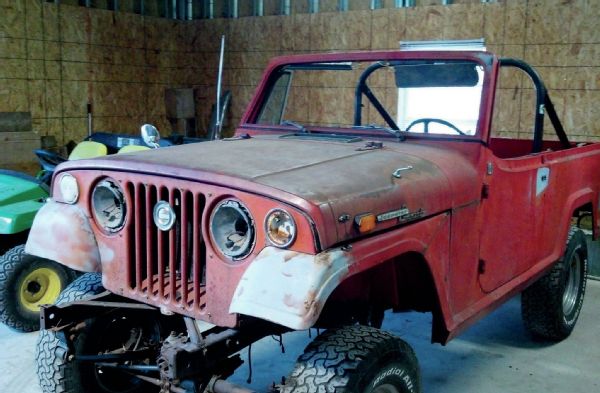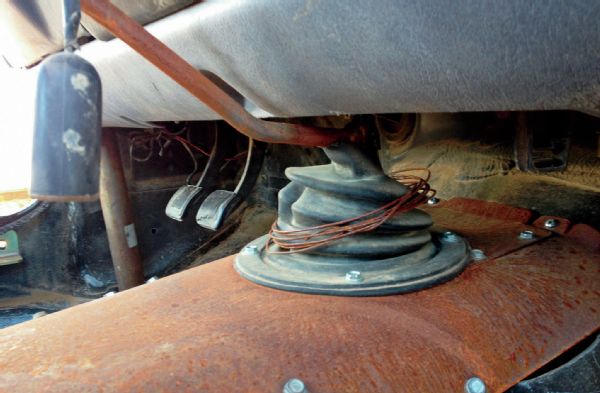
 John Cappa
Former Editor, Four Wheeler
John Cappa
Former Editor, Four Wheeler
AMC Burn
I have a ’78 CJ-5. The plug gap on the number-four cylinder of my AMC 304 keeps bridging. I notice the hesitation when it happens, pull it, clean it, and my Jeep works great after. How do I determine if it’s oil blowing past a valve guide or coming past the rings?
Jeremy Rendell
Via email
It sounds as though you might need to get your hands on a cylinder leakdown test tool. Harbor Freight (harborfreight.com) offers an inexpensive tool that should do the trick. It consists of a pair of gauges and a hose that threads into the spark plug hole. You can check the engine compression and test it for leaks past the rings and valves.
To start with, thread the tool into each spark plug hole and crank the engine over. Check the compression on the gauge and compare the results for each cylinder. They should be within 20 percent of each other. Low compression in a cylinder means you have a leak somewhere. Any cylinders with a low compression reading will require a closer inspection. Worn or damaged rings or valves have likely caused your leak. You can do a valve leakdown test by inserting a small amount of engine oil down the spark plug hole and reinstalling the test gauge. The oil will help seal the rings if that is where the leak is coming from. Slowly crank the engine over by hand to top dead center and monitor the gauge. If there still appears to be a leak, there may be something wrong with the valve seats, stem seals, or head gasket.

Another possibility could be that you simply have a weak spark on that cylinder. The AMC ignitions have never been known for burning hot or reliably. Check the plug wires, cap, rotor, and all connections for any corrosion, unusual wear, and damage. We’ve seen great performance results and improved ignition reliability from the installation of a Performance Distributors (performancedistributors.com) Davis Unified Ignition (D.U.I.) distributor. The D.U.I. allows a slightly wider plug gap and provides a significantly hotter spark than stock. It could be enough to solve your problem.
C-Clip Caper
I have a ’90 YJ with a four-cylinder. I want to get some stronger aftermarket axleshafts for the Dana 35. The problem is that apparently Jeep decided to put C-clip axles in some ’90s YJs and non-C-clip axles in others. Could you tell me how to tell the difference without opening up the rear axle? I would like to order them and then open it up to install them. It’s my only vehicle, so taking it off the road for the time it will take to order them isn’t an option.
Beau Holgate
Via email
The early YJs first came with non-C-clip Dana 35 rear axles. These Dana 35 axles are flanged axles and have a bearing retainer at the axle end. Unfortunately, ’90 was sort of a transitional year. Some Dana 35 axles were flanged and some were C-clip. The simplest way to identify what version you have is to put the rear of your Jeep on jackstands, remove one of the rear tires, and then remove the brake drum. You’ll want to look at the backing plate just behind the axle flange. If there is a rectangular plate around the axleshaft with four bolts holding it to the backing plate and axlehousing, then it is not a C-clip axle. The rectangular steel plate is the axle and bearing retainer for the flanged axle. If there is no bearing retainer, you have a C-clip axle.
Home Frame
I recently read about the frame you built for Project Ground Up (June ’12). What would be the frame measurements for a ’78 CJ-7?
Name withheld
Via email

All of the early Jeep CJs up to 1972, including Project Ground Up, have a simple straight frame. A simple straight frame can be easily built out of rectangular tubing. Unfortunately, the ’73-’87 CJs have a frame that splays out in the rear. That’s not to say a home fabricator cannot build it, but it’s a little more involved to keep everything straight. If you don’t have the fabrication skills to build a frame, you could order one from Throttle Down Customs (throttledownkustoms.com). The company offers many different Jeep frames with lots of cool options like built-in shackle reversals, transmission skidplates, flatfender YJ spring conversions, and more.
How-To Frame
I’m working on a ’69 Commando restoration crawler. It will ultimately be on 1-ton axles and have a modern drivetrain. I am curious to know how you guys built a square frame for project “Ground Up” (Aug. ’08). The layout of the rails and the reinforcement points are easy enough to understand, but getting the two rails square side to side and from overhead seems like a challenge. What am I missing or not understanding about building my frame?
Russ Kimzey
Via email
Building the two straight framerails for an older Jeep is a relatively simple fabrication project. You can do it with a minimal number of fabrication tools. The key is carefully measuring and straightening the frame bits prior to welding everything in place. Once you have your two straight framerails fabricated, you can marry them with crossmembers. But first, you need to check the assembly to make sure it’s square. Both of your framerails should be identical in length. To make them square to each other (not diamond-shaped), you can measure in an X pattern from the front of one rail to the rear of the other. Do this for both sides. Simply move the framerails until the measurements match to make the framerails square.
Most experienced fabricators use a chassis table or frame jig to build precision chassis. These tools are not exactly cheap or practical for an enthusiast shade-tree fabricator. They are typically made from very heavy and thick steel or aluminum to avoid warping and to make sure the platform you build off of is perfectly flat. Chassis tables sometimes have threaded holes every few inches to help clamp things in place prior to welding. For most Jeep frame applications, a flat slab of concrete is more than adequate. Some chassis builders have had success in using threaded jackstands. They typically use six stands and then adjust them so that they are level, prior to building a frame or chassis on top.

Willys Wonder
I have built a ’88 Wrangler to be a good-performing machine over the past four years, but I always wanted an old Willys pickup. Well, I have one now. I have been doing a lot of research on how to modernize it and make it more comfortable and reliable. I bought both an old fullsize Ford Bronco, and then a mid ’80s Chevy S10 pickup for the chassis/drivetrain donors. After a lot of research, I am now reconsidering keeping it on its original frame and just upgrading it. The IFS of the S10 seems sacrilegious for the Willys’ heritage, and the Ford Dana 44 up front seems too complicated and messy.
I want a reliable rig for trail riding. I only need enough lift for 33-inch tires, but I want fuel-injected reliability and a smooth ride for when the wife comes on trail rides. I have a spare Ford 9-inch rear axle and a high-pinion Dana 30 frontend, but I’m not afraid to go with something else. I’m mostly concerned about what will mate up easiest with the Willys frame or be the easiest drivetrain to drop it on.
I am split on auto versus manual, but I probably prefer an automatic transmission. The Spicer 18 transfer case can stay, but I don’t want to spend a fortune on adapters. The T-90 probably has to go as I intend to put it on the highway frequently and want to go faster than 45 mph, although overdrive transmissions seem pricey.
I let a free Wagoneer chassis slip through my fingers a year ago, and that might have been great, but it is gone now. I am not afraid to go out and buy a more suitable donor. I was thinking of a Jeep Comanche truck to stay with the Jeep elements I have become familiar with.
In short, I need a vision that gives me the above, but won’t take me five years to complete or get me in way over my head, I can fabricate pretty well, but get lost on steering geometry. I also intend to stretch the cab so I can fit inside comfortably. There is no bed on it now so the wheelbase is not a concern. I will fabricate a bed for it so I get a good departure angle.
Thanks for any thoughts you might provide—my head is spinning with all the options.
Brian Bauer
Via email

I have seen the Willys pickup bodies swapped onto several different chassis. One of the more popular chassis is the ’73-’87 GM solid axle 4x4 chassis. This would get you the modern drivetrain and even an overdrive transmission, depending on what year GM truck you start with. I was never a big fan of this swap, because the framerails become too obvious and ugly looking. It’s a relatively simple swap. The most difficult part is probably the wiring and building the mounts for the Willys cab and front clip.
Another more recent chassis donor for the Willys truck is a ’97-’06 TJ Wrangler. I know two people working on this swap and have seen a Willys wagon body (which is similar to the truck) dropped onto a TJ chassis by the designers at Jeep. You can read more about that Willys wagon in “Vintage Vestments” in the Aug. ’12 issue or online at fourwheeler.com.
Jpstaffer Verne Simons is actually working on a Willys truck using the TJ frame and suspension. You can see more about the project in the “Wicked Willys” series found on fourwheeler.com.
If you decide to keep your frame, the Ford 9-inch and Dana 30 can be used as long as they are of similar width. If you go this route, you will be in for a much more in-depth lesson on suspension and steering geometry—you’ll basically be starting from scratch. The factory Willys truck manual steering will be marginal with 33-inch tires, and the stock suspension will likely be too uncomfortable to keep. In your situation, I really think you’ll be better off going with the TJ frame and suspension, and maybe even the TJ engine, transmission, transfer case, and axles. You’ll get the modern fuel-injected drivetrain, a soft-riding suspension, reliable steering, and an overdrive automatic transmission, if you find the right year. I’d look for a good rolling chassis and drivetrain; maybe a Wrangler that was in a wreck or rollover that damaged the body beyond repair without bending the frame, suspension, and axles.
Shifter S-Turn
Good article on adding an SM420 granny four-speed to your TJ (“Granny Gearing,” Nov. ’14). I had been advised against this swap because of interference of the shifter with the dash panel. What troubles did you have? A picture of your shift lever and console would be great.
Doug Schnabel
Via email

In this application, the SM420 is pushed forward quite a bit and the shift tower is located underneath the dash as you mentioned. This is easy to overcome with a welder and a grinder. Verne simply cut off the shifter handle and extended it rearward. This allows the shifter to clear without moving the transmission or cutting into the dashboard. Most granny transmission swaps require some sort of shifter modification, because the throw on them is so great. It’s not unusual to see modifications like this.
SM420 Savvy
I was interested in your article about installing the SM420 into the four-cylinder TJ (“Granny Gearing,” Nov. ’14). I, too, would like to have a real granny gear, but don’t you have big gaps between your remaining three gears? If you do any normal street driving at all, it must be worse than it was with the AX5. Now you basically just have a three-speed on the street. I guess that would be OK with a V-8, but I don’t think I would do it to my four-cylinder. Any thoughts on this? What is it like in normal driving? Was it worth it?
Giles Blair
Via email
The additional low-range gearing from the SM420 First gear makes the TJ four-cylinder much more off-road worthy when doing slow-speed trail work. However, as a daily driver, the SM420 can be a handful and may be more than what most people are willing to drive regularly. You’ll almost never use the 7.02:1 First gear on the street, so you essentially have a three-speed transmission to work with. Also, the ratio gap between Second and Third gear is pretty substantial. You have to wind up the engine in Second gear to make a clean shift to Third.
There are many other ways to get lower gearing behind the TJ four-cylinder. The NV4500 is another possible transmission swap. It is a huge and heavy transmission, but with it you get the ultra-low First gear, an Overdrive gear, and a better ratio spread than the SM420. The NV4500 is also quite a bit more expensive than the SM420, so it really depends on what you are trying to accomplish and how much you want to spend. Not every swap makes sense for every Jeep enthusiast.
Write Us! Got a tech question you’re just itching to get answered? Send it on in to Jp Magazine, Your Jeep, 831 S. Douglas St., El Segundo, CA 90245, or e-mail it to jpeditor@jpmagazine.com.